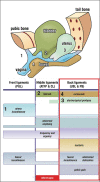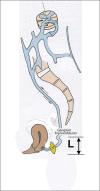Chronic pelvic pain of unknown origin may be caused by loose uterosacral ligaments failing to support pelvic nerve plexuses - a critical review
- PMID: 33552577
- PMCID: PMC7848843
- DOI: 10.5173/ceju.2020.0280
Chronic pelvic pain of unknown origin may be caused by loose uterosacral ligaments failing to support pelvic nerve plexuses - a critical review
Abstract
Introduction: Chronic pelvic pain of unknown origin (CPPU) affects the quality of life (QoL) of up to 20% of women. The 2005 Cochrane Review, based on randomized controlled trials (RCTs), stated that the pathogenesis of CPPU is poorly understood and its treatment is empirical and ineffective. Totally ignored were the high cure rates from uterosacral ligament (USL) repair, the principal subject of this review.
Material and methods: We carried out a review of literature on USL causation, diagnosis, and treatment of CPPU, selecting only the literature relevant to USL.
Results: The first mention of CPPU being caused by lax USLs was in the pre-WWII German literature by Heinrich Martius. In 1993, CPPU was described as one of the 4 pillars of the posterior fornix syndrome (PFS- CPPU, urgency, nocturia, abnormal bladder emptying). Cure/improvement of CPPU was reported by widely geographically separated surgical groups using squatting-based pelvic floor exercises and by shortening and reinforcing USLs with tension tapes, literally a reverse transvaginal tape. Patients can potentially be cured either by native tissue ligament repair or in older women a posterior sling can be tested using a speculum test or even menstrual tampons.
Conclusions: This technology, based on USL pathogenesis, which can be tested for potential cure, non-surgical or surgical, offers hope for women for a condition previously considered incurable. Chronic pelvic pain, bladder and bowel incontinence occur in predictable symptom groupings, which are associated with apical prolapse. USL repair, whether native tissue or (preferably) using a posterior sling has the potential to improve clinical practice, QoL for women and open new research directions.
Keywords: Allen-Masters syndrome; Integral Theory; chronic pelvic pain of unknown origin; overactive bladder; pelvic floor disorders; posterior fornix syndrome.
Copyright by Polish Urological Association.
Conflict of interest statement
The authors declare no conflicts of interest.
Figures




References
-
- McCredie JP, Skilling PM. Are ‘psychiatric’ findings in patients with Chronic Pelvic Pain primary or secondary? Pelviperineology. 2018;37:24–27.
-
- Bornstein J. The consensus terminology of persistent vulvar pain and vulvodynia. Pelviperineology. 2018;37:3–5.
-
- Walker E, Katon W, Harrop-Griffiths J, Holm L, Russo J, Hickok LR. Relationship of chronic pelvic pain to psychiatric diagnoses and childhood sexual abuse. Am J Psychiatry. 1988;145:75–80. - PubMed
Publication types
LinkOut - more resources
Full Text Sources
Miscellaneous
